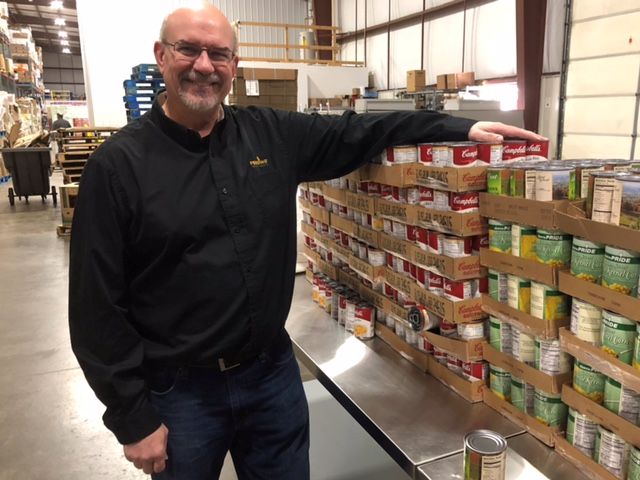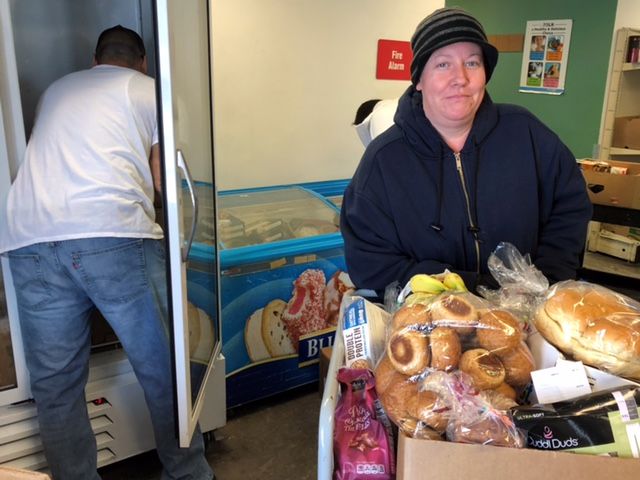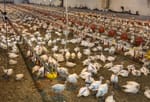RAPID CITY, S.D. – More than 40,000 South Dakota children, from infants to teenagers, live in families with incomes low enough to qualify for the federal food stamp program, creating challenges for a fruitful childhood and a prosperous adult life.
The number of children in South Dakota families receiving aid in the federal Supplemental Nutrition Assistance Program rose by 47 percent from 2007 to 2017.
Even with some recent improvements, the number of children living on food stamps is on a significant long-term rise in South Dakota.
Studies show that people who grow up in poverty can face educational, social and health challenges in childhood and adulthood.
About 42,265 children lived on food stamps last year. The number of children on food stamps in South Dakota spiked to nearly 50,000 during and after the Great Recession of 2008. But as the rest of the state and nation have mostly bounced back, the food stamp data show that lower-income families have been largely left out of the economic recovery.
“When the recession hit, it just pushed them all into that abyss and they could no longer make ends meet,” said Matt Gassen, CEO of Feeding South Dakota, the largest charity food provider in the state. “There’s an even bigger portion of those who didn’t make it out of poverty and are still behind.”
The jump in food stamp enrollment since the mid-2000s came as other child poverty indicators also ticked upward in the state, according to a recent report compiled by South Dakota KIDS COUNT, an outreach center at the University of South Dakota.
The review showed an increase in eligibility in the National School Lunch Program for low-income students and a significant rise in the number of children in families qualifying for Medicaid and the Children’s Health Insurance Program during that period.
The income, wage and government assistance data from South Dakota mirrors a national trend over the past decade in which childhood poverty increased. Between 2005 and 2017, 46 of 50 states saw a jump in the percentage of children in families that received some type of public assistance. In 2005, fewer than one in five American children lived in a family receiving public assistance, while last year that figure had risen to one in four, about 18.6 million children in all, according to the Annie E. Casey Foundation.
Despite some recent improvements, the nation continues to grapple with helping what researchers recently called a “stubbornly high” number of children in poverty.

Small gains, but poverty still nags
The most recent enrollment numbers for SNAP show slight declines in South Dakota. Enrollment in the SNAP program has dropped slightly in each of the past five years in South Dakota, according to Tia Kafka, spokeswoman for the Department of Social Services that administers the federal food stamps program.
Federal data show that 40,882 South Dakota households qualified for SNAP benefits in 2018, compared to 41,982 in 2017 and 42,705 in 2016. The number of children 17 or younger in those families fell accordingly during that time period, from 46,184 in 2016 to 42,265 last year.
Meanwhile, Gov. Kristi Noem said during her budget address in January that the state saw a drop last year in the number of people receiving benefits under some programs supported by the Medicaid program funded the state and federal governments.
Yet major challenges remain for thousands of families with children in South Dakota.
In an email to News Watch, Kafka said the SNAP program “helps families stretch limited budgets, improves nutrition and reduces the risk of diet-related health problems.”
Individuals and families qualify for food stamp benefits based if their gross income is under 130 percent of the federal poverty guidelines. A single person would qualify with an annual income of $15,800 or less, while a family of four qualifies with a total annual income of $32,640 or less.
Participants also cannot have bank accounts above $2,250 but can have a home and vehicle.
About two-thirds of SNAP recipients in South Dakota are children, elderly or disabled. The monthly benefits, which are based on nutritional need guidelines and family size, cannot be used to buy alcohol, tobacco, dry goods or household items, pet supplies, vitamins or medicines or take-out foods. In 2018, about $11 million a month in food stamps were issued in South Dakota, or roughly $130 million for the year, with an average payment of about $275 per family per month.
The premise behind food stamps is that obtaining nutritional food is critical to the viability of families and children, Kafka said. “Balanced nutrition is certainly important to child well-being, including physical health and cognitive development,” she wrote.
Georgia Christensen of Sioux Falls wants to welcome her new baby into a stable environment and couldn’t do that without aid from SNAP and other government programs.
Christensen has a learning disability that makes it tough to hold a job; she said she lost her $11-an-hour position cleaning offices last year because her boss said she moved too slowly. Her husband is also out of work.
Together, they are raising a teenage girl and have a baby due this month. Christensen said she isn’t sure how the family would get by without her $252 monthly food stamp allotment and the $741 monthly disability payment she receives from Social Security.
“It helps my family to get food because sometimes we don’t have the money to grocery shop,” said Christensen, who uses her food stamps all at once and tries to scrimp, plan meals for the month and visit local food pantries if necessary. “We run out towards the end of the month. It’s a struggle, and I do worry.”
Christensen, 34, was born in Winner, S.D., and grew up in Nebraska where she dropped out of high school at 16 and later returned to South Dakota. Her mother was on food stamps while she was growing up, she said.
“I don’t think people understand what it’s like to need food stamps,” she said. “Some people say that you guys are just living off the government or are too lazy to work, and that’s not true. There’s some people who can’t work or are disabled and they need the benefits.”
Christensen has no savings and receives medical benefits through Medicaid. She said her hopes for the future are limited by her inability to land and hold down a good job. “What I hope for in life,” she said, “is I hope that we can make it.”
Enrollment in food stamp program among S.D. children
Despite some recent improvements, the number of children living on food stamps is on a long-term rise in South Dakota. While the numbers spiked during the Great Recession, this chart shows that low-income families have not fully participated in the recovery.
Age 2007 2012 2017 10-year increase
0-4 11,539 17,863 14,411 25%
5-13 13,699 24,502 22,763 66%
14-17 4,457 6,788 6,565 47%
Total 29,695 49,153 43,739 47%
Source: South Dakota KIDS COUNT
Effects of poverty wide-ranging
A variety of studies by universities and child advocacy groups show evidence that children face numerous challenges when their family lives below the federal poverty line.
Studies over the years have indicated that children in low-income or food-challenged families do worse in school, are prone to sleep disorders, have a tendency toward anxiety, are less likely to participate in organized sports or recreational activities and receive lower quality child care at home or at centers outside the home. As they grow up, children raised in poverty have a higher rate of criminal activity, a lower rate of degree attainment, earn lower wages later in life and can be prone to obesity due to difficulty in affording healthier food.
Children in low-income families face a host of challenges not endured by those from wealthier families, according to a study released last month by the National Center for Children in Poverty, which is part of the Columbia University school of public health.
“Children are also more likely to suffer the material hardships associated with living in poverty: the anxiety, depression and constant stress of being financially vulnerable leaves a lasting mark on children as they grow to adulthood, affecting earning potential and health outcomes,” wrote Heather Koball, director of family economic security for the group.
The study contained some good news on poverty trends. The center found that the number of poor children has declined slightly over the past few years.
On the positive side, the group found that overall the number of poor children fell from 44.9 percent of the population, or 33.2 million children, in 2010 to 41.2 percent, or 29.8 million children, in 2016.
The number of children living in “deep poverty,” or at only 50 percent of the national poverty income threshold, fell by about 2 million from 2010 to 2016, the group reported.
However, some findings from the group painted a bleaker picture, including that child poverty numbers remain “stubbornly high” across the country. The group found that the younger a child is, the more likely they are to live in poverty. The group reported that children whose parents work full time and have college degrees are less likely to live in poverty. The report also indicated that poverty rates among children had not fallen significantly in many minority communities, including Native Americans.
Gassen, of Feeding South Dakota, said some people have a misimpression of what poor people in the state look like.
“Poverty doesn’t look like a ghetto or a Third World country in South Dakota; it’s here and it’s everywhere,” Gassen said. “It could be the child at the playground, the neighbor coming home from work or the parents and child you sit next to in church on Sundays.”
Gassen said his group – which distributed 13.6 million pounds of food to needy people in fiscal 2017 — has seen a steady increase in the demand for nutritional food for low-income adults and children in South Dakota in recent years.
The need among children spikes during summer and holiday breaks when children aren’t being fed at school. To help low-income children, the group distributed about 191,000 bags of food that fit into backpacks and can easily be made without adult supervision, up from roughly 182,000 given out the prior year.
The recent federal government shutdown sent a scare through food stamp recipients and charities that provide food.
During the shutdown, the government issued February food stamp allotments in late January, about three weeks earlier than usual.
As a result, fears have risen that there may be a food stamp gap in late February and early March that causes a rush on pantries and desperation among families.
If another shutdown occurs soon, things will get even tighter for families on SNAP as they try to balance food needs and availability of benefits, said George Rokusek, western operations manager for Feeding South Dakota.
“They’ll be in uncharted waters if that happens,” Rokusek said. “Nobody knows if those March [SNAP] funds with come through and that’s a very scary thing.”

Low wages, disabilities hold families back
Cathy Brechtelsbauer of Sioux Falls, state coordinator for Bread for the World, a group that fights hunger, said low-income families in South Dakota were hit hard by the Great Recession of 2008 and continue to be hurt by stagnant wages that haven’t kept up with inflation.
“This whole time since that recession, we’ve never seen a great recovery among the lower incomes,” Brechtelsbauer said. “People have gotten jobs, but it’s not like incomes have picked up at that lower range.”
A recent News Watch analysis of wages in South Dakota showed that the state has the third-lowest average wage in the nation and that a great number of state residents who are employed full time are struggling to get by. According to federal Department of Labor data from 2017, roughly 21 percent of employed South Dakota residents, about 87,000 people, make under $30,000 a year; 41 percent of employed South Dakota residents, about 169,400 people, make under $35,000 a year, and 71 percent of employed South Dakota residents, about 292,000 people, make under $40,000 a year.
“People are working but the wages are still hardly covering their expenses,” Brechtelsbauer said.
Lisa Henley’s two children are well aware that their family is on government assistance, and the realization for them is painful.
The stress and stigma of poverty rise to the surface when they go to school and notice how their peers dress or when they sleep over at a friend’s home and see the abundance of technology, toys and food not present in their own home.
Her 9-year-old daughter and 12-year-old son know that their mother is just getting by and that their daily meals are provided through food stamps and trips to food pantries, she said.
“It affects them a lot,” said Henley, 39, who lives in Summerset in southwestern Meade County. “It’s hard for me and them when I have to tell them, ‘Sorry, honey, I can’t afford that right now.’”
Henley has recently worked as a waitress and pizza shop employee but became unemployed when she slipped in the shower and broke her wrist.
“It’s a wage issue but it’s also a ‘people don’t want to work’ issue,” Henley said of the high SNAP numbers in South Dakota.
Even when she worked both jobs, Henley made so little that she qualified for the federal food stamps program. She receives about $400 a month in SNAP benefits, which helps but doesn’t provide full food stability. “Things cost so much that it never goes far enough,” she said.
Henley visits charity food pantries from Rapid City to Sturgis to stock up on staples when food stamps fall short. On a recent day, she visited the Rapid City food bank run by Feeding South Dakota, which allows clients to get a cart full of goods once every two months.
She gathered up bread and English muffins, fruits, frozen meats and a bag of nearly outdated chocolate truffles.
“We’ll eat just about whatever we can get, wherever we can get it,” she said.



